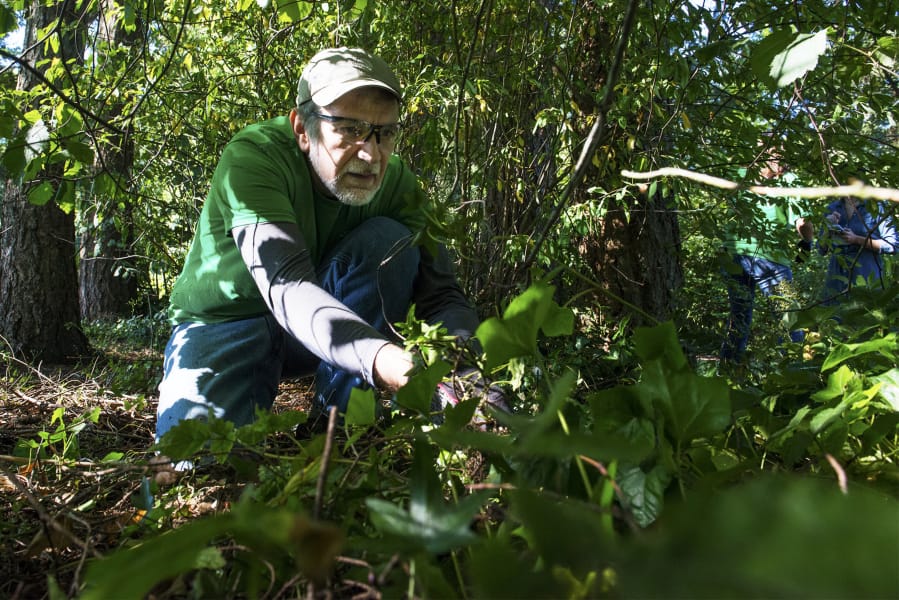When heading into battle with invasive English ivy, it’s best to have a plan of attack.
You could go at it like Vancouver’s Chuck Baker — he plants his feet, winds his hands into the weeds and yanks backward, straining at the knees.
“Gets out your aggression,” shrugged Baker, who joined Vancouver’s Ivy Near Elimination, or VINE, Squad with his daughter and grandson Thursday morning.
Or you could go the route of Donovan Wark. The 21-year-old Camas volunteer on the VINE Squad, a local group dedicated to ridding the area of English ivy, is no stranger to the weed. He whacks a rake into the middle of the thicket, swirls it around like a giant fork of spaghetti and rips the wad of vines from the ground.
If You Go
• What: Vancouver’s Ivy Near Elimination, or VINE, Squad.
• When: 9 to 11 a.m. July 26, Aug. 9 and Aug. 23.
• Where: Tenny Creek Neighborhood Park (July 26 and Aug. 23), LeRoy Haagen Memorial Community Park (Aug. 9).
• Info: Clark County Parks, 360-397-2285 ext. 1627. RSVP at tinyurl.com/vinesquad
“It’s a trick I use at home,” Wark said. “I still remember the first day I had to pull the ivy from the trees. We got basically done with it, except for these vines that were a little high … we got a ladder, we were swinging off the trees like Tarzan, still wouldn’t come down.”
English ivy — or Hedera helix, Latin for “coiling vine” — is among the hardiest and most pervasive invasive plants in the Pacific Northwest. First introduced in the United States by European immigrants, the plant gained popularity as a decorative vine for scaling vertical surfaces and hanging onto its green leaves year-round.
It’s deceivingly pretty, said Erika Johnson, master gardener coordinator at the Washington State University Clark County Extension Office.
“They have a history of climbing up a building and making it look pretty spectacular and elegant,” Johnson said. “There was an esteem around it — the ivy-covered halls.”
The commercial popularity quickly took a turn, Johnson said, as the species promptly swallowed up local ecosystems with a dense blanket of leaves.
It’s such an effective invader because the ivy doesn’t need much water or light to thrive compared with native plants. And while it’s illegal to sell Hedera helix at nurseries, gardeners can buy other types of ivy that interbreed with the English variety.
It doesn’t offer much to the local ecosystem, Johnson said. The vines don’t provide food to any native animals and only create shelter for other imports, such as rats.
“You might have had a place that had a variety of native plants. Now all you have is this blanket that doesn’t provide anything,” she said.
“Oftentimes plants are brought to an area where people don’t realize they’re going to be problematic,” Johnson continued. “When they’re brought to a native area, they outcompete, because the native ecosystem isn’t used to dealing with them. So they grow quickly, they crowd out everything else that was there.”
That’s certainly the case with English ivy, which is so ubiquitous it seems nearly invisible.
When the VINE Squad’s 18 volunteers got to hacking at the ground at Leroy Haagen Memorial Community Park, little islands of brown earth began to appear in a sea of green — green that most passers-by likely assume is supposed to be there.
“It’s just all greenery. And then, once you see it, your eyes are opened,” said VINE Squad volunteer Tonya Baker.
The VINE Squad is a collaboration between Clark County Parks and Vancouver’s City Volunteer Program. It was first formed last year by Dora Hernandez, with county parks, and Sam Moullet, with the city program.
Last year, volunteers removed enough English ivy to fill 4½ school buses, Hernandez said. They turned out despite intense heat and, on one occasion, thick smoke from the Eagle Creek Fire in the Columbia River Gorge.
“When we first start, it’s usually a little slower, but I think as people get word of what we’re doing, they come out and it grows in the summer,” Hernandez said.
For each event in the year — six in all — the volunteers usually fill a 10-cubic-yard collection bin, the volume equivalent of 10 washing machines, Moullet said.
The VINE Squad works in collaboration with the parks maintenance staff in controlling the ivy growth. The goal is to use as much manual labor as possible.
“Ideally, when you’re trying to eradicate an invasive plant, you want to do two methods,” Hernandez said. “This is the mechanical means, and then there’s also chemical means. We want to minimize the amount of chemical that’s being actually put into the parks.”
That’s easier said than done, according to Johnson, who’s battled more than her fair share of weeds in her lifetime. This one, she said, is most annoying.
“A thorny blackberry, you can get your loppers in, you can get your shovels around,” Johnson said. “With ivy, you just keep pulling and pulling and pulling. It’s a real pain.”
She recommends avoiding the plant altogether by turning to native alternatives — year-round greenery that will give the same effect as English ivy, such as Kinnikinnick or a crinkle-leaf creeper.
“There are lots of other alternatives, but I think those are two of the better ones,” Johnson said.




